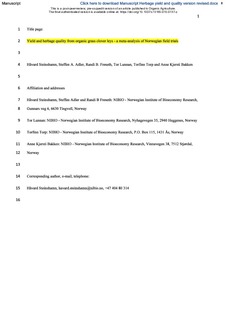| dc.contributor.author | Steinshamn, Håvard | |
| dc.contributor.author | Adler, Steffen Andreas | |
| dc.contributor.author | Frøseth, Randi Berland | |
| dc.contributor.author | Lunnan, Tor | |
| dc.contributor.author | Torp, Torfinn | |
| dc.contributor.author | Bakken, Anne Kjersti | |
| dc.date.accessioned | 2017-12-21T14:29:03Z | |
| dc.date.available | 2017-12-21T14:29:03Z | |
| dc.date.created | 2015-11-09T11:40:31Z | |
| dc.date.issued | 2016-12 | |
| dc.identifier.citation | Organic Agriculture. 2016, 6 (4), 307-322. | nb_NO |
| dc.identifier.issn | 1879-4238 | |
| dc.identifier.uri | http://hdl.handle.net/11250/2473584 | |
| dc.description.abstract | A meta-analysis based on experiments in organically cultivated grasslands in Norway was conducted to quantify the effects of management factors on herbage yield and feed quality. A dataset was collected that included 496 treatment means from experiments in five studies carried out at eight locations with the latitude range of 58.8 to 69.6 N between 1993 and 2010. We tested the effect of harvesting system (two vs. Three cuts annually), plant developmental stage at the first cut, growth period (temperature sum) and the herbage clover proportion. Plant maturity at the first cut and herbage clover proportion explained to a large extent herbage yield and quality of the first cut and annual yield. The timing of the first cut influenced also the yield and herbage quality of the second cut. The analysis confirmed the importance of legumes performance for herbage yield and quality from grasslands in organic production. Estimated annual herbage DM yield harvested at standardized plant development stage and at average clover proportion was 9%higher in the two—compared to the three-cut system. The crude protein concentration and in vitro dry matter digestibility was 17 and 3 % higher and the NDF concentration 7 % lower in the annual herbage from the three-cut than from the twocut system, respectively. The empirical equations developed in this study may be applied to explore different options for grassland management as basis for ration and production planning and in scenario analysis of economic performance of individual and model farms. The equations do also reveal in numeric terms the tradeoffs in management practice between high yields, yield digestibility, NDF and crude protein content in organic forage production relying on red clover N2 fixation as the engine in the system. | nb_NO |
| dc.language.iso | eng | nb_NO |
| dc.publisher | Springer Netherlands | nb_NO |
| dc.title | Yield and herbage quality from organic grass clover leys—a meta-analysis of Norwegian field trials | nb_NO |
| dc.type | Journal article | nb_NO |
| dc.type | Peer reviewed | nb_NO |
| dc.description.version | acceptedVersion | nb_NO |
| dc.rights.holder | © Springer Science+Business Media Dordrecht 2015 | nb_NO |
| dc.source.pagenumber | 307-322 | nb_NO |
| dc.source.volume | 6 | nb_NO |
| dc.source.journal | Organic Agriculture | nb_NO |
| dc.source.issue | 4 | nb_NO |
| dc.identifier.doi | 10.1007/s13165-015-0137-z | |
| dc.identifier.cristin | 1287220 | |
| dc.relation.project | Norges forskningsråd: 207755 | nb_NO |
| cristin.ispublished | true | |
| cristin.fulltext | postprint | |
| cristin.qualitycode | 1 | |
